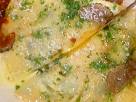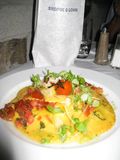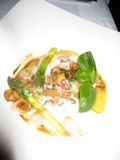Growing up in a Boston-Irish-Catholic family in the ‘50s and ‘60s, I ate many times my weight in cheese ravioli. Frozen cheese ravioli. With zigzaggy “pinked” edges.
They were a staple on Friday nights, when meat was banned from the dinner table. And when I went off to college I swore I’d never look at a plate of ravioli again.
For decades I didn’t.
 Then I discovered the glamorous egg raviolo at San Domenico in New York City. The sheer pasta package held a mixture of ricotta cheese, parmesan, fresh white truffles and a barely cooked egg yolk. The sauce was simple browned butter with a blizzard of shaved truffle. When I nudged it with my fork, the bright yellow egg rushed out and mixed with the nutty butter and earthy truffles. But since that moment, I’ve been a fan of filled pasta – ravioli, agnolotti, pansotti, cappelletti, fagottini and many more. (Sadly, San Domenico has closed its doors. The photo here is from The Food Network.)
Then I discovered the glamorous egg raviolo at San Domenico in New York City. The sheer pasta package held a mixture of ricotta cheese, parmesan, fresh white truffles and a barely cooked egg yolk. The sauce was simple browned butter with a blizzard of shaved truffle. When I nudged it with my fork, the bright yellow egg rushed out and mixed with the nutty butter and earthy truffles. But since that moment, I’ve been a fan of filled pasta – ravioli, agnolotti, pansotti, cappelletti, fagottini and many more. (Sadly, San Domenico has closed its doors. The photo here is from The Food Network.)
Last month, while vacationing in Austria and the Süd Tirol region of northernmost Italy, I really got to indulge my passion for the pasta pockets.
In fact, I ate some riff on ravioli just about every day.
 In Vienna, my husband and I dined twice at our favorite neighborhood eatery Skopik & Lohn.
In Vienna, my husband and I dined twice at our favorite neighborhood eatery Skopik & Lohn.
Both nights, the daily menu featured a cloud-like ricotta-arugula ravioli. One evening it was sauced with a very discreet pesto, sun-dried yellow and red tomatoes and tender micro greens (pictured here). The other night the dish was showered with sauteed local mushrooms and toasted pine nuts. Both dishes were remarkable for their fresh flavors and delicate interplay of textures. Located in Leopoldstadt (Vienna’s 2nd District), Skopik & Lohn is a charming spot with a cozy, wood-paneled interior and a sprawling sidewalk terrace with tables separated by pretty potted plants. The place’s “attitude” is as remarkable as its food. Hosts, servers and bartenders are cheerful and welcoming. And there’s always a nice buzz…the sound of people enjoying themselves.
 Chef Harald Riedl of Restaurant Vincent also has a winning way with ravioli. On the night we visited this Leopoldstadt restaurant, the large pasta rounds were a true celebration of springtime: filled with pureed sweet baby peas and topped with bright green asparagus tips. The dish also included caramelized sweetbreads, a bit of diced tomato, softly whipped cream and shiny basil leaves. Vincent is one of the city’s most elegant restaurants, with one of the most sophisticated menus. Riedl, who won a Michelin star at his former restaurant, prepares Austrian specialties with a French flair. His dishes are highly imaginative and very refined. The restaurant has three rooms, each with a different personality. I gravitate to the warm, cozy “stube,” but it’s the stylish, dressier “winter garden room” in back that’s designated non-smoking.
Chef Harald Riedl of Restaurant Vincent also has a winning way with ravioli. On the night we visited this Leopoldstadt restaurant, the large pasta rounds were a true celebration of springtime: filled with pureed sweet baby peas and topped with bright green asparagus tips. The dish also included caramelized sweetbreads, a bit of diced tomato, softly whipped cream and shiny basil leaves. Vincent is one of the city’s most elegant restaurants, with one of the most sophisticated menus. Riedl, who won a Michelin star at his former restaurant, prepares Austrian specialties with a French flair. His dishes are highly imaginative and very refined. The restaurant has three rooms, each with a different personality. I gravitate to the warm, cozy “stube,” but it’s the stylish, dressier “winter garden room” in back that’s designated non-smoking.
Eierschwammerltascherl. The word is bigger than the filled pasta pocket itself. Eierschwammerl are basically the same mushrooms that the French call chanterelle. A “tascherl” is a pocket or what the Italians call ravioli.
In June, the kitchen at Glacis Beisl took full advantage of both chanterelle and asparagus season by creating tender, nearly sheer rounds filled with a duxelle of mushrooms and herbs. The sauce was a puree of white asparagus, cream and microgreens.
 Glacis Beisl, located in the MuseumsQuartier, is a hip nightspot with terrific food, great value, a respected wine program and one of the most enchanting gardens I’ve ever seen. Lighted by old-fashioned Christmas lights, it features a profusion of plants and flowers, rickety picnic tables and benches, gravel underfoot and the stars above. This photo comes from a blog called Merisi. The site is a beautiful, entertaining and practical way to learn about Vienna.
Glacis Beisl, located in the MuseumsQuartier, is a hip nightspot with terrific food, great value, a respected wine program and one of the most enchanting gardens I’ve ever seen. Lighted by old-fashioned Christmas lights, it features a profusion of plants and flowers, rickety picnic tables and benches, gravel underfoot and the stars above. This photo comes from a blog called Merisi. The site is a beautiful, entertaining and practical way to learn about Vienna.
Wild garlic, known as Barlauch in German-speaking lands, is another treat that’s available in June. At Procacci, my favorite Italian restaurant in Vienna, chef Lorenzo DiMartino stuffs ethereal pasta pockets with a puree of wild garlic, mascarpone and finely diced tomatoes. They’re dreamy.

Comments